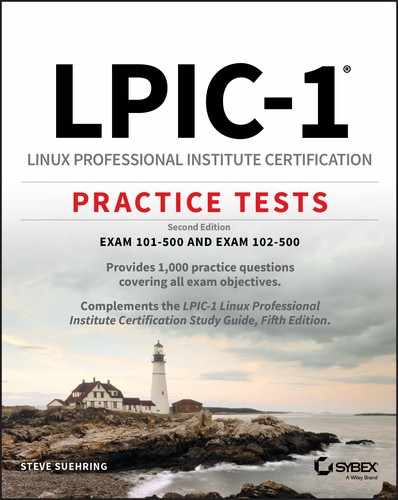Introduction
This book provides practice questions for the Linux Professional Institute LPIC-1 certification. Specifically, the book has been updated to reflect the objectives for exams 101-500 and 102-500. The book includes numerous multiple-choice questions related to the exam objectives found on the LPI website. Each chapter of the book connects directly to one of the objectives, and each objective is covered throughout the book. In addition, two practice exams are included in the book that you should find helpful in preparing for the exams. The book does not require that you start at the beginning and read through in a linear, page-by-page manner. Rather, you may skip to objective areas that might be less familiar, and you can do so without losing any fidelity or missing something from a previous chapter. It is assumed that you would have a companion text for this book in order to obtain deeper information on the given subjects for the exam. However, it is possible to use this book as a stand-alone means for preparation. Here are some basic assumptions about the audience for this book: This book is best used as a tool for testing your knowledge in the objective domains specified for the exam. The book provides explanations for each question, including, where applicable, explanations as to why the other options were incorrect. Ideally, the book is used in conjunction with the companion text in order to fully explain the concepts. The Linux Professional Institute outlines various policies related to certification and other similar matters. In addition, other policies applicable may be through the testing facility or organization. More information on some of the LPI policies can be found at www.lpi.org/policies. The following lists contain the topics and weights for Exams 101 and 102. This list follows the sequence in which they are covered in the book. You can find more information about what is covered in each topic, including key knowledge areas and files, terms, and utilities, at the start of the applicable chapter. Topic 101: System Architecture Topic 102: Linux Installation and Package Management Topic 103: GNU and UNIX Commands Topic 104: Devices, Linux Filesystems, Filesystem Hierarchy Standard Topic 105: Shells and Shell Scripting Topic 106: User Interfaces and Desktops Topic 107: Administrative Tasks Topic 108: Essential System Services Topic 109: Networking Fundamentals Topic 110: SecurityWhat Does This Book Cover?
Who Should Read This Book
How to Use This Book
Certification Exam Policies
Exam Objectives
Exam 101-500
Exam 102-500
